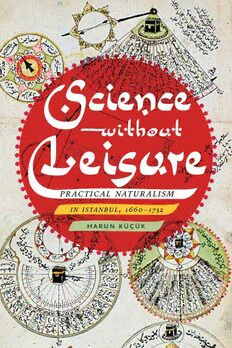
Science without Leisure: Practical Naturalism in Istanbul, 1660-1732 PDF
Preview Science without Leisure: Practical Naturalism in Istanbul, 1660-1732
Science without Leisure Science —without Leisure — —PRACTICAL NATURALISM I—N ISTANBUL, 1660–1732 HARUN KÜÇÜK UNIVERSITY of PITTSBURGH PRESS Published by the University of Pittsburgh Press, Pittsburgh, Pa., 15260 Copyright © 2020, University of Pittsburgh Press All rights reserved Manufactured in the United States of America Printed on acid-free paper 10 9 8 7 6 5 4 3 2 1 Cataloging-in-Publication data is available from the Library of Congress ISBN 13: 978-0-8229-4580-2 ISBN 10: 0-8229-4580-0 Cover art: Qibla indicators, Kandilli MS 198, 36a–b. Cover design: Alex Wolfe In memory of Ayfer Küçük (1956–2016), the kindest person I have ever known. Residents of Istanbul buy clocks and other curious miscellany that come from the land of the Franks. And, as these things work and are of high quality, they take the commodities as an indication of the Franks’ mastery of the art of medicine and of the sciences. They believe that the Franks have seen and cured most of the diseases at their anatomical theaters and academies. And, they believe Franks have mastered medicine because of their endless experience with each and every ail- ment. Let us for a moment assume that this is the case. What are these highly trained physicians doing here in Istanbul in the first place? Why are they taking part in the sufferings of the people here, when they can make a good living at the hospitals back home? —GEVREKZADE HAFIZ HASAN (D. 1801), CHOICEST TREATISE ON EYE SURGERY Just as Darwin discovered the law of development of organic nature, so Marx discovered the law of development of human history: the simple fact, hitherto concealed by an overgrowth of ideology, that mankind must first of all eat, drink, have shelter and clothing, before it can pursue politics, science, art, religion, etc.; that therefore the production of the immediate material means of subsistence and consequently the degree of economic development attained by a given people or during a given epoch form the foundation upon which the state in- stitutions, the legal conceptions, art, and even the ideas on religion, of the people concerned have been evolved, and in the light of which they must, therefore, be explained, instead of vice versa, as had hitherto been the case. —FRIEDRICH ENGELS Contents Acknowledgments ix Notes on Naming Conventions, Translation, and Transliteration xv INTRODUCTION After Science: Ottoman Practical Naturalism 3 CHAPTER 1 Istanbul and Her Sciences 33 CHAPTER 2 Istanbul’s Medreses in the Fifteenth and Sixteenth Centuries 55 CHAPTER 3 The Ottoman Scholastic Field and the Sciences 83 CHAPTER 4 The Calendar: Copernicus for Tax Collectors 108 CHAPTER 5 The Recipe: An Annotated Chronology of New Medicine in the Seventeenth Century 143 CHAPTER 6 Distinction: A Social Critique of Scientific Taste 167 CHAPTER 7 Like Ants on a Watermelon: Practical Naturalists Encounter Philosophy 183 CHAPTER 8 Maritime, Mercantile, Sacred: Empiricism and the Compass 204 CONCLUSION 223 APPENDIX 1 Extract from Tezkireci I˙brahim, Secencelü’l-Eflak fi Gayeti’l-I˙drak [Mirror of the Heavens at the Edge of Understanding] (1662) 237 APPENDIX 2 Extract from I˙brahim Müteferrika, Füyuzat-ı Mıknatısiye [Magnetic Effluvia] (1732) 241 APPENDIX 3 Extract from I˙brahim Müteferrika, Usülü’l-Hikem fi Nizamü’l-Ümem [Foundations of Government in Various Social Orders] 244 Notes 249 Bibliography 287 Index 315 viii • Contents Acknowledgments It took me three book projects to get to this one. As a trained Europeanist, I started out by trying to deploy my young-scholar-level knowledge of intellectual history and of the history of science to ask whether we could speak of an Enlightenment in the Ottoman Empire. Then I simply focused on eighteenth-century episodes that I thought I could passably analyze, which turned into a few short essays and book chapters. It was not until I turned to the seventeenth century that the general shape and trajectory of science in the Ottoman Empire began to gain some clarity. And only in the last few months of my academic leave in 2016–2017 did I feel a sense of pattern, however much of an illusion that sense may prove to be. That is, it took me about a decade to convince myself, and I made mistakes along the way. It felt like driving uncomfortably fast on a bumpy road. Many people helped me, accompanied me, and put up with me along the way. First, I want to thank my advisor, Robert Westman, for his guidance and patience. My interest in the history of science all started with his article “The Astronomer’s Role in the Sixteenth Century.” I was lucky to work with him. He nursed the bad writer and the hasty thinker that I always have been. And, if it were not for him I would not have had either the will or the resources to see what to me seemed like a big project to completion. I would also like to thank Hasan Kayalı, whose generosity and openmindedness has made my years in San Diego both edifying and rewarding. The late John Marino, with whom I spent almost two years discussing early modern European history, awakened me to social and economic history and generally to how history is done. Luce Giard has been the patron saint of my work from the moment we met. I would not know nearly as much about Aristotelianism and the Jesuits without her. Finally, Frank Biess’s research seminar gave me the opportunity to think more seriously about education in modern Turkey. I would also like to thank Tom Gallant, Naomi Oreskes, Tal Golan, Cynthia Truant, and Steven Eps- tein. Finally, the late S¸erif Mardin gave me my first education in social ix
